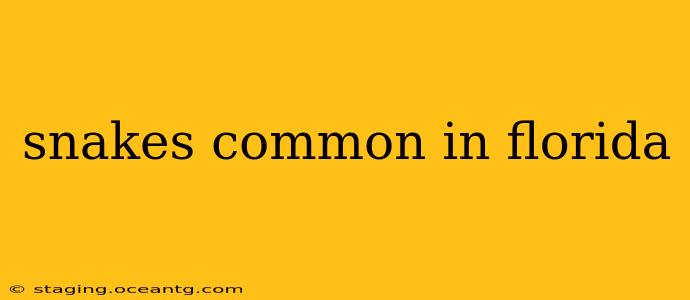Florida's diverse ecosystem boasts a rich variety of snake species, some harmless and beneficial, others potentially dangerous. Understanding which snakes are common in the Sunshine State is crucial for both residents and visitors to ensure safety and appreciate the natural world. This guide delves into the most frequently encountered snakes in Florida, outlining their characteristics and behaviors.
What are some common non-venomous snakes in Florida?
Many non-venomous snakes call Florida home, playing vital roles in the environment. These often-misunderstood reptiles are crucial for controlling rodent populations and maintaining ecological balance. Some of the most common include:
-
Black Rat Snake ( Pantherophis obsoletus): A large, powerful constrictor, often mistaken for a venomous snake due to its size and dark coloration. They are typically black or dark gray, but juveniles can exhibit patterns. They are excellent climbers and often found near human dwellings, feeding primarily on rodents. They are not aggressive and will usually flee if disturbed.
-
Corn Snake (Pantherophis guttatus): Known for their beautiful patterns and docile temperament, corn snakes are popular pets. In the wild, they inhabit a variety of habitats, including fields, forests, and even urban areas. They are relatively small and feed mainly on rodents.
-
Eastern Garter Snake (Thamnophis sirtalis): These slender snakes are common throughout Florida and come in various color variations. They are active hunters, primarily feeding on amphibians, fish, and earthworms. They are harmless to humans.
-
Brown Snake (Storeria dekayi): This small, secretive snake is often overlooked. They are typically brown or gray, with a very slender body. They feed primarily on earthworms and slugs and are completely harmless.
What are some common venomous snakes in Florida?
While Florida boasts a large number of non-venomous snakes, several venomous species also reside in the state. Understanding their characteristics is paramount to safety.
-
Eastern Diamondback Rattlesnake (Crotalus adamanteus): The largest venomous snake in North America, the Eastern Diamondback is easily identifiable by its characteristic diamond-shaped patterns and rattle. They are ambush predators, preferring wooded areas and grasslands. Respect their space and avoid approaching them.
-
Cottonmouth (Agkistrodon piscivorus): Also known as a water moccasin, the cottonmouth is a semi-aquatic snake found near swamps, marshes, and other water bodies. They have a distinctive dark, almost black body and a broad head. When threatened, they may open their mouth to reveal a white interior, hence the name "cottonmouth".
-
Copperhead (Agkistrodon contortrix): Copperheads are a medium-sized venomous snake recognized by their coppery-brown color and hourglass-shaped markings. They are relatively shy and prefer wooded areas and rocky outcrops. They are less aggressive than other venomous snakes but still pose a threat if provoked.
-
Coral Snake (Micrurus fulvius): Coral snakes are brightly colored snakes with distinctive bands of red, yellow, and black. Their venom is highly toxic and neurotoxic. They are shy and secretive snakes, spending most of their time underground. Their bite can be life-threatening, emphasizing the importance of avoiding them.
What is the most venomous snake in Florida?
While several venomous snakes in Florida pose significant threats, the Eastern Diamondback Rattlesnake is generally considered the most dangerous due to its size, venom potency, and propensity for inflicting serious bites. However, any venomous snake bite requires immediate medical attention.
How can I identify a venomous snake in Florida?
Identifying venomous snakes requires caution and attention to detail. While there are exceptions, venomous snakes in Florida generally exhibit some common characteristics: triangular head shape, heat-sensing pits (in pit vipers like copperheads and cottonmouths), and a rattle (in rattlesnakes). However, relying solely on these features can be dangerous. It's best to err on the side of caution and avoid handling any snake you cannot positively identify as non-venomous.
What should I do if I encounter a snake in Florida?
Encountering a snake in Florida shouldn't automatically trigger panic. Most snakes are harmless and pose no threat to humans. However, it's important to follow these guidelines:
- Maintain a safe distance: Give the snake ample space; do not approach or attempt to handle it.
- Observe from afar: Appreciate the snake from a distance; take note of its characteristics for possible identification.
- Never try to kill a snake: Unless it poses an immediate threat, leave the snake alone. Snakes play a vital role in the ecosystem.
- If bitten, seek immediate medical attention: Call emergency services and describe the snake if possible.
Remember, responsible coexistence with Florida's snake population involves understanding, respect, and a healthy dose of caution. By familiarizing yourself with the common species and following safety precautions, you can coexist peacefully and appreciate the diversity of this fascinating ecosystem.
